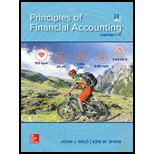
The stockholders’ equity section of TVX Company on February 4 follows.

On February 5, the directors declare a 20% stock dividend distributable on February 28 to the February 15 stockholders of record. The stock’s market value is $40 per share on February 5 before the stock dividend.
- 1. Prepare entries to record both the dividend declaration and its distribution.
- 2. Prepare the stockholders’ equity section after the stock dividend is distributed. (Assume no other changes to equity.)
1.
Prepare entries to record both the dividend declaration and its distribution.
Explanation of Solution
Stock dividends: Stock dividends are the number of shares issued by a company to the existing shareholders in a proportion equal to the number of shares owned by each shareholder, based on a stock dividend percentage.
Prepare the journal entry to record the dividend declaration as follows:
| Date | Account Titles | Debit ($) | Credit ($) |
| February 5 | Retained earnings (1) | 480,000 | |
| Common stock dividend distributable (2) | 120,000 | ||
|
Paid in capital in Excess of par value, Common stock (3) | 360,000 | ||
| (To record the declaration of 20% common stock dividend) |
Table (1)
- Stock dividend is a component of stockholder’s equity account. While issuing stock dividend retained earnings will decrease. Thus, debit retained earnings account to decrease the retained earnings balance.
- Common Stock dividend distributable is a liability account and it is increased. Therefore, credit Common Stock dividend distributable account.
- Paid in capital in Excess of par value, Common stock is a component of stockholder’s equity account and it is increased. Therefore, credit paid in capital in Excess of par value, Common stock account.
Working Notes:
Compute the number of shares to be issued as dividend.
Compute the decrease in retained earnings.
Compute common stock dividend distributable.
Compute paid-in capital in excess of par value.
Prepare the journal entry to record the dividend declaration as follows:
| Date | Account Titles and Explanation | Post Ref. | Debit ($) | Credit ($) |
| February 28 | Common stock Dividend Distributable (2) | 120,000 | ||
| Common stock, $10 par value | 120,000 | |||
| (To record common stock dividend distributed) |
Table (2)
- Common Stock dividend distributable is a liability account and it is decreased. Therefore, debit Common Stock dividend distributable account.
- Common Stock is a stockholders’ equity account and it is increased. Therefore, credit Common Stock account.
2.
Prepare the stockholders’ equity section after the stock dividend is distributed.
Explanation of Solution
Prepare the stockholders’ equity section after the stock dividend is distributed.
| Company TVX | |
| Balance Sheet (Partial) | |
| As of February 28 | |
| Particulars | Amount ($) |
| Paid-in Capital: | |
|
Common stock, $10 par value, 150,000 shares authorized, 72,000 shares issued and outstanding | $720,000 |
| Paid-in capital in excess of par value, common stock | 785,000 |
| Total paid-in capital | $1,505,000 |
| Retained earnings | 70,000 |
| Total stockholders’ equity | $1,575,000 |
Table (3)
Compute total number of shares issued and outstanding.
Compute common stock value.
Compute Paid-in capital in excess of par value, common stock.
Compute total number of shares issued and outstanding.
| Particulars | Amount ($) |
| Retained earnings before stock dividend | $550,000 |
| Less: Stock dividend issue | 480,000 |
| Retained earnings after stock dividend issue | $70,000 |
Table (4)
Want to see more full solutions like this?
Chapter 13 Solutions
Principles of Financial Accounting.
- Principles of Accounting Volume 1AccountingISBN:9781947172685Author:OpenStaxPublisher:OpenStax College
 Financial And Managerial AccountingAccountingISBN:9781337902663Author:WARREN, Carl S.Publisher:Cengage Learning,
Financial And Managerial AccountingAccountingISBN:9781337902663Author:WARREN, Carl S.Publisher:Cengage Learning, Intermediate Accounting: Reporting And AnalysisAccountingISBN:9781337788281Author:James M. Wahlen, Jefferson P. Jones, Donald PagachPublisher:Cengage Learning
Intermediate Accounting: Reporting And AnalysisAccountingISBN:9781337788281Author:James M. Wahlen, Jefferson P. Jones, Donald PagachPublisher:Cengage Learning  EBK CONTEMPORARY FINANCIAL MANAGEMENTFinanceISBN:9781337514835Author:MOYERPublisher:CENGAGE LEARNING - CONSIGNMENT
EBK CONTEMPORARY FINANCIAL MANAGEMENTFinanceISBN:9781337514835Author:MOYERPublisher:CENGAGE LEARNING - CONSIGNMENT College Accounting, Chapters 1-27AccountingISBN:9781337794756Author:HEINTZ, James A.Publisher:Cengage Learning,
College Accounting, Chapters 1-27AccountingISBN:9781337794756Author:HEINTZ, James A.Publisher:Cengage Learning,





